The Cauvery river tumbles majestically down the Shivasamudram Falls, also called the Shivanasamudram Falls. Located in Mandya district in Karnataka state, the Shivasamudram Falls has twin jumps, Gaganachukki and Bharachukki, one km away from each other. Torrential rains in the Cauvery basin and the flooding of the river Kapila added more power and lustre to the beautiful scene. We were standing on the watchtower viewing the falls along the banks of the river Cauvery.
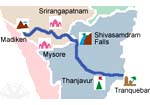
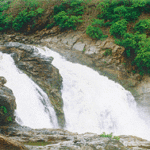 After getting down the bus at Shivasamudram, which is popularly called Bluff, we walked along the banks of Cauvery for two km through green fields interposed hither and thither with multitudes of young trees before we approached the waterfall.
After getting down the bus at Shivasamudram, which is popularly called Bluff, we walked along the banks of Cauvery for two km through green fields interposed hither and thither with multitudes of young trees before we approached the waterfall.
From the watchtower, one can view the falls where the river plunges downward in a wonderful cascade, sending up dense clouds of mist, presenting a breathtaking scene. We sat on one of the stone benches overlooking the falls which plunges to a depth of 300-350 ft. Shivasamudram falls is the second biggest water falls in India.
Cauvery, called the Ganga of the South, takes its birth at Talacauvery in western ghats in Kodagu district and traverses through Hassan, Mysore, Mandya and Bangalore districts, joining with rivers Harangi, Hemavathi, Lakshmana Thirtha and Kapila. Before coursing into Tamilnadu, it leaves behind many resplendent waterfalls in its course, among which Shivasamudram falls is an important one.
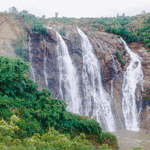 At Shivasamudram, the river branches into two, creating the second largest island in its course. There are a group of ancient temples situated in this island. It is believed that very long ago there was a village in this island. Each branch of the river at Shivasamudram has a separate falls – the western falls known as Gagana Chukki and the eastern falls, Bhara Chukki.
At Shivasamudram, the river branches into two, creating the second largest island in its course. There are a group of ancient temples situated in this island. It is believed that very long ago there was a village in this island. Each branch of the river at Shivasamudram has a separate falls – the western falls known as Gagana Chukki and the eastern falls, Bhara Chukki.
The 90-metre falls on the river rushing through the huge boulders attract the tourists during July-August when the river Kabini also floods along with Cauvery.
Bhara Chukki lies a km or so away from Gagana Chukki. On the way to Bhara Chukki, we visited an ancient dargah situated along the bank, which attracts hundreds of Muslims everyday to visit and worship. After a few yards of walk, we found Bhara Chukki falls, raising a dense mist to a height of about 300 ft. Multitudes of tourists, new couples and youngsters come here to see the natural beauty in its magnificent glory. Compared to Gagana Chukki, Bhara Chukki wears a more serene look, owing to the steady sheet of water falling without many boulders hindering its course downward. Both Gagana Chukki and Bhara Chukki are a paradise for the nature lovers.
After the turbulent fall, the river traverses in a quite manner through a thick green valley at a depth of about 400 feet towards the east.
Shivasamudram is also famous for its hydro power station which was started in 1902 by Sheshadri Ayyar, a dewan of Mysore. This is said to be the first hydro power station in Asia and from here power was supplied to Bangalore — the first city to get power in India – in 1906 and then to Kolar Gold Fields and Mysore.
Map of the Cauvery River
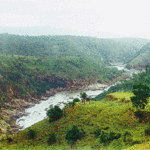 In the hydro station, power is produced by running the water through a pipe having sufficiently larger diameter and kept at an inclined position from a height of 350 ft. Through a turbine, the hydraulic force of water is transmitted to an alternator which generates electric power.
In the hydro station, power is produced by running the water through a pipe having sufficiently larger diameter and kept at an inclined position from a height of 350 ft. Through a turbine, the hydraulic force of water is transmitted to an alternator which generates electric power.
There was a trolley for the visitors to see the panoramic view of the Shivanasamudram falls and the working of the hydro station. But now, unfortunately, those who want to go for a trolley ride, return with disappointment. It is because the use of trolley was stopped six years ago when a militant group vowed that it will blow up the hydro station. If the authorities commence the trolley ride again, it will attract more visitors.
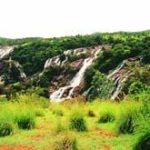 Shivasamudram lies in its unpolluted ambience which adds beauty to the place. Nearby the falls, there are no shops, bars and restaurants or any other kind of disturbance. However, it needs basic facilities such as water, shelter and toilet. Better facilities will no doubt attrabct more tourists.
Shivasamudram lies in its unpolluted ambience which adds beauty to the place. Nearby the falls, there are no shops, bars and restaurants or any other kind of disturbance. However, it needs basic facilities such as water, shelter and toilet. Better facilities will no doubt attrabct more tourists.
Copyright © Cauvery All rights reserved worldwide.
